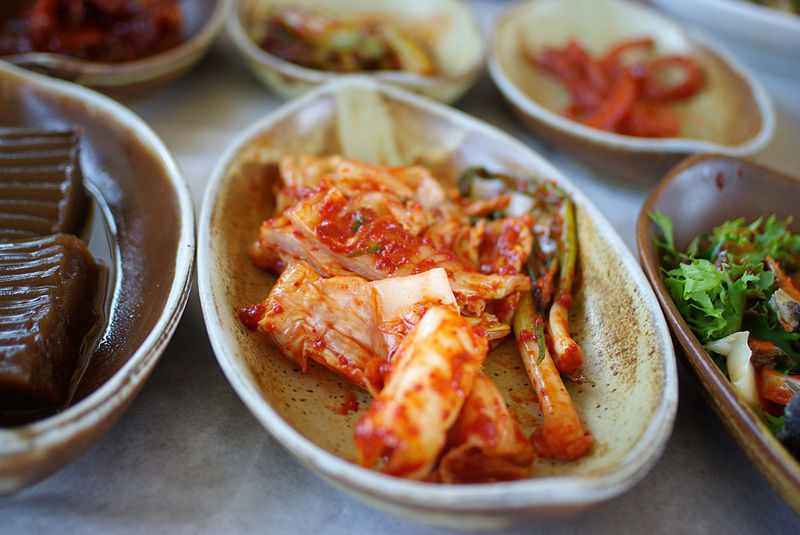While this is going on, the other ingredients are assembled and mixed together. (Ground pepper powder, chopped garlic and ginger, pickled baby shrimp -or other sea food pickled such as anchovies and other fishes as a form of row fish cut in bitable size, sponge seaweed- and oysters can be added depending taste and family recipes.)
When they are mixed and the cabbage is ready. For common baech'u kimchi the softened cabbages are cut in to bitable size and mix with other ingredients. For Tongbaechu kimchi, handfuls of the stuffing are then pushed and spread between the leaves of the cabbage until it is all used. The outer leaves of the cabbage are wrapped round whole to form a solid bundle, which is then stored in a crock covered with salted leaves and pressed down firmly.
It is the most popular winter Kimchi made by packing the 'so', the blended stuffing materials, between the layers of salted leaves of uncut, whole cabbage.
It varies by region. There are cold northern areas and warm southern areas divided by each climate.
In the former, this Kimchi tastes neither spicy nor hot, rather insipid. On the other hand, in the latter, it is salty, hot, and juicy. In the middle area, it is properly salty and juicy. In the northern area, the 'so', the blended stuffing materials, is not used much, but spices and seasoning are added to finely shredded radish and then those are put sparsely between the heart of white cabbage.
Meanwhile, in the middle area, a large amount of the 'so' is made to be sufficiently put between every layer of leaves of the cabbage. In the southern area, it is common to plaster the 'so' mixed with strong salted seafood juice and glutinous rice paste over the whole cabbage
info credit:
http://www.lifeinkorea.com/food/Food.cfm?Subject=kimchi
http://www.koreanrestaurantguide.com/kimch/kimchi_type.htm
......................................................................................................................................................
Baechu Kimchi recipe
Main Ingredients:
1 Large Napa Cabbage
2 Cups Korean Radish
1 Cup Garlic Chives
5 Green Onions
1 Onion
2 Hot Peppers
Salt Water for Cabbage:
10 Cups Water
½ Cup Coarse Sea Salt (For Salt Water)
⅔ Cup Coarse Sea Salt (For Sprinkling)
Sauce Ingredients:
2 Cups Water + (3 Tbsp Water and 3 Tbsp Sweet Rice Flour)
¼ Sweet Apple + ¼ Onion
1¼ Cup Red Pepper Powder for Kimchi
1 to 2 Tbsp Sugar
¼ to ⅓ Cup Fish Sauce
3 Tbsp Minced Garlic
½ Tbsp Minced Ginger
½ Tbsp Salt
2 Tbsp Sesame Seeds
Directions:
1. Remove any bad parts from the napa cabbage.
2. Divide 1 the napa cabbage into 4 pieces. Some people divide it half, but I prefer 4 pieces, since it’s easier to put in a jar and cut later.
3. In a huge bowl, combine 10 cups of water and ½ cup coarse sea salt to make salt water. Stir until the salt is dissolved.
4. Prepare ⅔ cup coarse sea salt. Divide the salt evenly for 4 pieces of cabbage. Sprinkle the salt inside each leaf. Put more salt on the thicker parts than the thinner parts. This step is important to make kimchi. The right amount of salt and time to marinate the cabbage will change the results of your kimchi.
5. Dip the cabbage in the salt water. Put some heavy thing (like big pan with water) on top of the cabbage to keep them under water. That will help them get salted better. Leave them for 4 to 5 hours until the cabbage leaves become a little soft.
6. Rinse the salted cabbage twice in water.
7. Drain the water, and set it for about 2 hours until the water drips out. Or you can squeeze the water out, after sometime.
8. Mix 3 Tbsp of sweet rice flour and 3 Tbsp of water.
9. In a pan add the mixture and 2 cups of water. Boil it until it makes bubbles on medium. Keep stirring it so that it will not stick to the bottom. (It took about 10 minutes for mine.)
10. Cut the radish very thinly into 2 inch lengths.
11. Cut 5 green onions the same length as the radish.
12. Cut the garlic chives into 1½ inch Pieces.
13. Cut 2 hot peppers thinly and slice ¾ onion thinly.
14. Grind ¼ of an onion and ¼ of an sweet apple.
15. In a big bowl, add the rice flour mixture, 1¼ cup of red pepper powder, and 2 cups of radish. Mix well.
16. Then add the rest of the ingredients: chopped onion, hot peppers, garlic chives, green onion, onion & apple mixture, 1~2 Tbsp of sugar, ¼ to ⅓ cups of fish sauce, 3 Tbsp of minced garlic, ½ Tbsp of minced ginger, and 2 Tbsp of sesame seeds. Mix all of the ingredients well. Taste it and salt it to your tastes. I added ½ Tbsp of salt.
17. Spread some of the mixture into each leaf of the cabbage. Make sure all of the surfaces get covered in the sauce.
18. Wow, at last, it’s done !!!
recipe credit: http://aeriskitchen.com/2009/01/napa-cabbage-kimchi-%EB%B0%B0%EC%B6%94-%EA%B9%80%EC%B9%98baechu-kimchi/
......................................................................................................................................................
Baechu Kimchi Recipe (Korean cabbage pickle) | Korea | Whats4Eats
Kimchi, a strongly flavored and odoriferous pickle, is one of the bedrocks of Korean cuisine. Koreans have been salting vegetables in one form or another
http://www.whats4eats.com/pickles/baechu-kimchi-recipe
Kimchi - Wikipedia, the free encyclopedia
Baechu kimchi is the most common type of kimchi in the fall. It is prepared by inserting blended stuffing materials, called sok (literally meaning inside), ...
History - Main ingredients - Kimchi varieties - Nutrition and health
http://en.wikipedia.org/wiki/Kimchi
Korean Food: Kimchi
Baechu Kimchi (Whole Cabbage Kimchi) Baechu Kimchi This is the most common, classic kimchi you will find at a Korean meal. Whole heads of cabbage are ...
http://www.lifeinkorea.com/food/Food.cfm?Subject=kimchi

